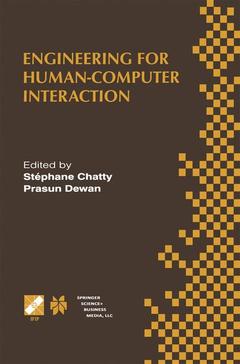Description
Engineering for Human-Computer Interaction, 1999
IFIP TC2/TC13 WG2.7/WG13.4 Seventh Working Conference on Engineering for Human-Computer Interaction September 14–18, 1998, Heraklion, Crete, Greece
IFIP Advances in Information and Communication Technology Series, Vol. 22
Coordinators: Chatty Stéphane, Dewan Prasun
Language: English
Subject for Engineering for Human-Computer Interaction:
Publication date: 01-2013
382 p. · 15.5x23.5 cm · Paperback
382 p. · 15.5x23.5 cm · Paperback
Description
/li>Contents
/li>Biography
/li>
The aim of IFIP Working Group 2.7 (13.4) for User Interface Engineering is to investigate the nature, concepts and construction of user interfaces for software systems. The group's scope is: ? developing user interfaces based on knowledge of system and user behaviour; ? developing frameworks for reasoning about interactive systems; and ? developing engineering models for user interfaces. Every three years, the group holds a "working conference" on these issues. The conference mixes elements of a regular conference and a workshop. As in a regular conference, the papers describe relatively mature work and are thoroughly reviewed. As in a workshop, the audience is kept small, to enable in-depth discussions. The conference is held over 5-days (instead of the usual 3-days) to allow such discussions. Each paper is discussed after it is presented. A transcript of the discussion is found at the end of each paper in these proceedings, giving important insights about the paper. Each session was assigned a "notes taker", whose responsibility was to collect/transcribe the questions and answers during the session. After the conference, the original transcripts were distributed (via the Web) to the attendees and modifications that clarified the discussions were accepted.
Embodied user interfaces: Towards invisible user interfaces.- Efficient strategies for selecting small targets on pen-based systems: an evaluation experiment for selection strategies and strategy classifications.- Utilising a geographic space metaphor in a software development environment.- Early experience with the mediaspace CoMedi.- Modelling unwarranted commitment in information artefacts.- Using the B formal approach for incremental specification design of interactive systems.- Engineering component-based, user-configurable collaborative editing systems.- Generic and composable latecomer accommodation service for centralized shared systems.- Help generation for task based applications with HATS.- Toward the automatic construction of task models from object-oriented diagrams.- Methods for identifying usability problems with web sites.- Employing simulation to evaluate designs: The APEX approach.- Frameworks and patterns for synchronous groupware: AMF-C approach.- MAMP: A design model for object-oriented visualization systems.- An architecture model for the hypermedia engineering process.- Towards a framework and procedure for specifying user interfaces.- Support for iterative user interface prototyping: The Sherlock Guideline Management System.- Deriving presentations from task models.- Workshop on Technical Feasibility: Initial Lessons from an IFIP WG2.7 Virtual University Case Study.- The Visualisation of Web Usage.- External Requirements of Groupware Development Tools.- Keyword index.
Stéphane Chatty is at the Centre d'Études de la Navigation Aérienne, Toulouse, France. Prasun Dewan is at the Department of Computer Science, University of North Carolina at Chapel Hill, USA.
© 2024 LAVOISIER S.A.S.

